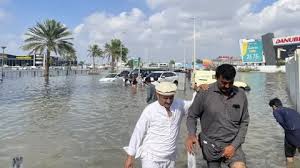
Did flooding occur in dubai as a result of cloud seeding?

Over the past 24 hours, record-breaking rains in dubai have given rise to false rumors regarding cloud seeding. In what ways was the rainfall extraordinary, and what caused the heavy downpours?
How much of a downpour did it make?
Dubai is a coastal city in the United Arab Emirates (UAE) that experiences mostly dry weather. Although the average annual rainfall is less than 100mm (3.9in), there are sporadic, intense downpours.
Less than 100 kilometers (62 miles) from dubai, in the city of Al-Ain, around 256 millimeters (10 inches) of rain fell in a single day. The primary culprit was a "cut off" low pressure weather system that pulled warm, humid air in and prevented other weather systems from passing through. This was an extremely rare rainfall event, according to Prof. Maarten Ambaum, a meteorologist at the university of Reading who has researched rainfall patterns in the gulf region. "This region of the world has been defined by long periods without rain and then irregular, heavy rainfall," he says.
What's cloud seeding, and was it involved?
By modifying current clouds, cloud seeding helps to increase the amount of rain that falls. One way to achieve this is to use aircraft to drop tiny particles into clouds, such as silver iodide. Then, it will be easier for water vapor to condense and transform into rain. The uae has recently employed the method, which has been around for decades, to deal with water scarcity. Some social media users incorrectly linked the harsh weather in the hours after the floods to recent cloud seeding efforts in the nation. According to earlier reports from Bloomberg, cloud seeding planes were used on sunday and Monday, but not on tuesday during the floods. Experts claim that emphasizing cloud seeding is "misleading" and that, at most, it would have had little impact on the storm, even though the BBC has not been able to independently confirm when cloud seeding occurred.




 click and follow Indiaherald WhatsApp channel
click and follow Indiaherald WhatsApp channel